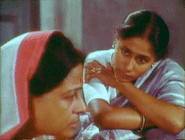Nearly a decade after the release of his three-part magnum opus Calcutta 71, Mrinal Sen would rekindle the specter of famine, exploitation, and poverty within the collective consciousness of contemporary society to create an equally haunting and introspective exposition into the nature of human suffering in In Search of Famine. Structured as a film within a film on a Calcutta-based film crew as they converge on the rural village of Hatui in order to shoot a film set during the Bengali Famine of 1943 (a wartime, man-made famine caused by the diversion of food supplies by the British colonial government to support the military campaign in Asia), In Search of Famine is also a trenchant examination into the universality – and perpetualization – of class division, ignorance, cultural arrogance, and economic polarization.
A seemingly informal tour of the crew’s guest accommodations and the surrounding estate grounds of the impressive, but deteriorating, near empty zamindari that will also serve as a setting for one of the film’s more lavish sequences incisively captures the economic reality of the entire village, as the crew’s travel manager explains his difficulty in obtaining several sets of keys from their respective owners in order to gain access into all of the rooms of the estate after the individual heirs inevitably shuttered their inherited spaces over the years and moved away in search of a better life elsewhere. With the zamindari now singularly tended by the sole remaining heir still living on the premises, an elderly woman (Gita Sen) unable to leave because of the constant attention demanded by the care of her paralyzed, ailing husband, the estate has fallen into a state of disrepair and neglect (note the theme of paralysis and entrapment that Sen similarly captures in his subsequent film, Khandahar. Watching the crew’s activities from the balcony with equal measures of curiosity, estrangement, longing, and despair, the landlady’s only interaction comes from the daily visits of a poor young woman from the village named Durga (Sreela Majumdar) who works a series of odd jobs for several households (and subsequently, the film crew) in order to make ends meet after the amputation of her husband’s arm in a work-related accident. In still another fateful encounter, a weaver and former theatrical actor named Haren (Rajen Tarafder) attempts to curry favor (or more likely, employment) by insinuating himself into the elaborate production, acting as an ineffective, self-appointed liaison between the alternately bemused and skeptical villagers and the presumptuous film crew. Through their figurative subservience to the film crew, Sen creates an implicit correlation with the desperate prostitution of women during the 1943 famine (as suggested in the film project by the heroine’s association with construction workers from Calcutta).
Perhaps the most implicit reflection of the theme of pervasive, metaphoric famine is through a series of pictorial guessing games that the film crew engages in order to pass the time. Through randomly selected research photographs that the director (Dhritiman Chatterjee) has brought on location to study the “face of famine” – a sketch depicting the second century Gandgar statue entitled The Starving Buddha, a 1959 mini famine that ravaged Bengal, a 1971 humanitarian crisis brought about by the Bangladesh War – Sen refutes the notion that famine is an isolated historical incident brought about by the specific intersection of war, colonialism, social division, and food shortage, but rather, results from the conscious, socially motivated, symptomatic aftermath of man-made human suffering.
it is interesting to note that the symbolic sound of roaring machinery that is used to indicate the presence of (unseen) airplanes flying over the village during the film project (a motif that also evokes Satyajit Ray’s film on the 1943 famine Distant Thunder) is also repeated in the din of portable generators brought by the crew to power film equipment in the electricity-less estate, and further reinforces the idea of the cosmopolitan film crew as intrusive noise-makers within the rural (and essentially backward) village. Within this context, the interrupted conversation between the leading actress (Smita Patil) and the landlady as she shares her memories of life during the famine that is abruptly truncated by the sound of activated generators can be seen as a broader metaphor for the film crew’s delusive pursuit of capturing realism through aesthetic manipulation and artificial construction. In essence, the villagers’ disparate, but interrelated circumstances of abject poverty, misguided pride, and emotional compromise reflect the intrinsic dichotomy between the myopia of the film crew’s elusive quest to capture the authenticity of the 1943 human tragedy in their “search for famine” from the perspective of a privileged outsider’s gaze, and the economic, spiritual, and emotional impoverishment – the inescapable famine – that continues to define the everyday reality of the marginalized living in the periphery of their well-intentioned, but insulated gaze.
© Acquarello 2006. All rights reserved.
